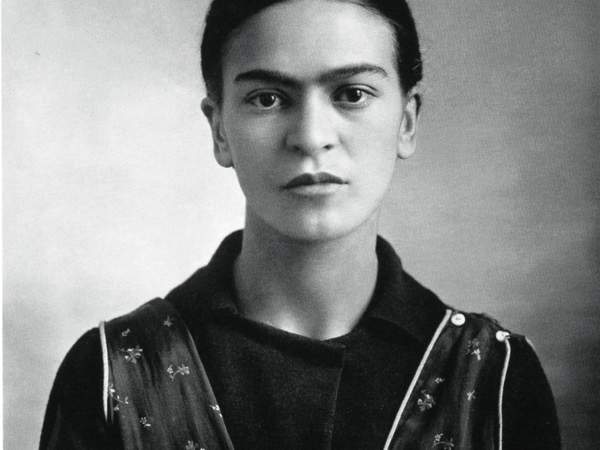Frida Kahlo. A Life in Images is the title of the exhibition promoted by theCulture Department of the Municipality of Alberobello, and organized by Bass Culture srl and Rjma Cultural Projects in collaboration with Locus Festival and Diffusione Italia Internationalche, open to the public until Oct. 8, 2023.
“The path under the banner of the internationalization and cultural innovation of Alberobello is traced,” explains Valeria Sabatelli, councillor for Culture, who adds that "among the artists who in the 20th century stood out for their originality of content and expression, we have chosen Frida Khalo, who became an icon of the generational revolution and women’s emancipation, for her art and especially for the events of her countercultural life, extraordinarily documented by photos taken by some of the greatest photographers of the 20th century." The exhibition is set up in the Museum of the Territory - Casa Pezzolla, protected byUNESCO and consisting of 15 communicating trulli, where the uniqueness of rural architecture will meet with images of Frida and her Casa Azul in Mexico City, which has now become the much-visited Frida Kahlo Museum.
The exhibition will be accompanied by side events such as a concert by Max Gazzè with theOrchestra della Notte della Taranta on June 30 in largo Martellotta, a performance by Frida Bollani Magoni on August 7 at Trullo Sovrano and a series of literary events organized by theSpine Cultural Association inside the striking Casa Pezzolla.
“The gender revolution that sees in Frida a pioneering figure,” adds Mayor Francesco De Carlo, "has been present in every activity of my executive since she took office. From the first European project No women No panel to the identification of qualified female figures in the political/institutional and managerial spheres."
Through a hundred or so shots, most of them original, the exhibition, curated by Vincenzo Sanfo, reconstructs the events of the great Mexican artist’s countercultural life, in search of the motivations that turned her into a female and pop icon internationally. The photos were taken by her father Guillermo during his daughter’s childhood and youth and then by some of the mostÌ€ great photographers of her era, to whom an installation in the garden of Palazzo Pezzolla is dedicated: Leo Matiz, Imogen Cunninghan, Edward Weston, Lucienne Bloch, Bernard Silbertein, Manuel and Lola Alvarez Bravo, Nickolas Muray and others. This extraordinary “photo album” chases the often painful but always passionate events of a life, as well as Frida’s loves, friendships and adventures. A group of very intimate small photographs of Frida, taken by gallery owner Julien Levy, are also on display in the exhibition.
The exhibition itinerary first reconstructs the context in which her personality took hold: it is early 20th century Mexico, traversed by a revolution that changed its history, thanks to humble campesinos and heroic protagonists such as Pancho Villa and Emiliano Zapata. The epic and myth of the Mexican revolution would remain etched in Frida’s mind and shape her indomitable character, fueling her sense of rebellion against bourgeois conventions and the impositions of a strongly masculinist societyÌ€. Against this backdrop are the events of the Kahlo family. Guillermo, the father, is a professional photographer of German origin who came to Mexico in 1891 and soon fell in love with the country that welcomed him.
In the exhibition he is pictured with Matilde Calderon, his wife and mother of four children, including Frida.
A number of lithographs by Rufino Tamayo along with the original catalog of Frida’s exhibition, organized in Paris, the first “manifesto of revolutionary painting” signed by Breton and Rivera are to testify to the vibrant artistic culture that characterized Mexico in the first decades of the century.
Of mixed blood, German and Mexican, Frida grew up in the myth of a revolutionary Mexico and found in painting a passionate, visceral language with strong, unapologetically autobiographical content, with which she told her story without hypocrisy. All his work is a form of self-analysis, in search of his own identity and reason for living. In his many self-portraits he is not afraid to lay bare his own weaknesses and anxieties. Alongside Frida is often portrayed Diego Rivera, the painter and muralist with whom she shared an intense and turbulent relationship that spanned much of her life. But other figures such as Leon Trotsky and André Breton also appear.
The exhibition concludes with a video that brings together the few filmed images of the great Mexican artist. The reception and exit room features a photographic documentation of her famous Casa Azul, which, after her death, Diego Rivera donated to the Mexican state to create the Frida Kahlo Museum.
The entire exhibition is accompanied by an audio guide available to all visitors, included with the ticket. The catalog, edited by Vincenzo Sanfo, is published by Papiro Art.
For all information, you can call +39 393 9639865.
Pictured: Guillermo Kahlo, Portrait of Frida Kahlo after the death of her mother. Mexico, 10/16/1932. Silver gelatin print, vintage
 |
| Alberobello, Frida Kahlo's life told through photographic images |
Warning: the translation into English of the original Italian article was created using automatic tools. We undertake to review all articles, but we do not guarantee the total absence of inaccuracies in the translation due to the program. You can find the original by clicking on the ITA button. If you find any mistake,please contact us.